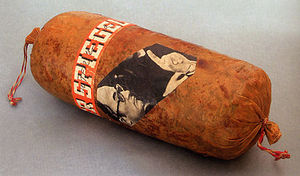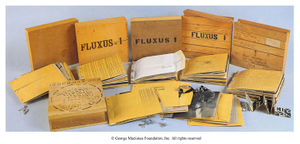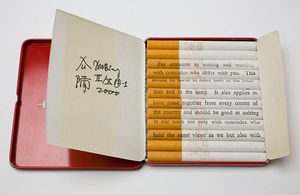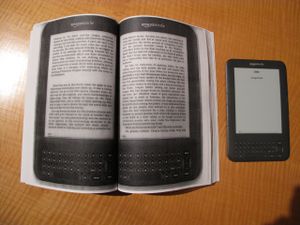Some thoughts and Inspiration
Physical Photobook - Digital Photobook 5 February 2015 – Who gives a f*ck!?
Forget the last proposal, I was losing myself, and was to focus on the ‘physical’ aspect of the book. After a long thought I got to the conclusion that I have to make something for myself and not for the ‘assignment’. I was making ideas to fit within the project, with a traditional reference in my mind. That’s NOT me. This book has no rules, or guidelines, so we are free to make whatever we want. We talk about what is a physical book or digital book, for my conclusion; they could be the same. When I print a digital photo in a book, then it becomes physical. But it’s still a digital photo, so you combine digital and physical. For mine digital book ideas I notice that I’m looking for the boundaries of a photobook. When is a book a book? When is it a photobook? This is a question for a long them in the art world. For example the Fluxus experiment a lot with books. I want to experiment with books with a digital touch to it. Like a 3D printed book.
+ 3D Book: A book printed from a 3D machine, not to read. It looks like a book and it’s a book. Maybe there is some massage inside, but you never know. ‘Real’ books will be replace by this one, the fake books. We are going to read online, or the eReader, or our own screens. Then the bookcase consist of fake books, just for decoration.
+ File size Books: A photo printed in binary code and save the photo in different form, like pdf, jpg, psd ect. The all have their different KB size, and you can see that from the book sizes. How bigger the file, the more pages it’s got.
+ Screen Photobook: A book with a digital photo frame in side. Where everyone can play their own photos in the book.
+ Template Books: A book with the templates what the company gives to you when you are making a photobook. Print the template to a physical book. I want to try several companies templates.
Literaturwurst (Literature Sausage) is an Artist's book, made by the Swiss-German artist Dieter Roth between 1961 and 1974. Each book was made using traditional sausage recipes, but replacing the sausage meat with a book or magazine. The cover of the edition was then pasted onto the skin of the sausage and signed and dated.
Grapefruit is an artist's book written by Yoko Ono, originally published in 1964. It has become famous as an early example of conceptual art, containing a series of "event scores" that replace the physical work of art – the traditional stock-in-trade of artists – with instructions that an individual may, or may not, wish to enact. Event Scores, involve simple actions, ideas, and objects from everyday life recontexualized as performance. Event Scores are texts that can be seen as proposal pieces or instructions for actions. The idea of the score suggests musicality. Like a musical score, Event Scores can be realized by artists other than the original creator and are open to variation and interpretation
Fluxus 1 is an artists' book edited and produced by the Lithuanian-American artist George Maciunas, containing works by a series of artists associated with Fluxus, the international collective of avant-garde artists primarily active in the 1960s and 1970s. Originally published in New York, 1964, the contents vary from edition to edition, but usually contain work by Ay-O, George Brecht, Alison Knowles, György Ligeti, Yoko Ono, Robert Watts and La Monte Young amongst many others.
Red Book by Xu BingTobacco Pay attention to uniting and working with comrades who differ with you. This should be borne in mind both in the localities and in the army. It also applies to have come together from every corner of the country and should be good at uniting in our work not only with comrades who hold the same views as we but also with
Mémoires (Memories) is an artist's book made by the Danish artist Asger Jorn in collaboration with the French artist and theorist Guy Debord. Printed in 1959, it is the second of two collaborative books by the two men whilst they were both members of the Situationist International.
It has a sandpaper cover, so it destroys other books when you put it in your bookshelf.
Digital Reference:
Martin Brink – ‘Grass’ A ebook with a photo http://www.martinbrink.se/post/88563987091/grass-ebook
Sebastian Schmeig - 56 BROKEN KINDLE SCREENS http://sebastianschmieg.com/56brokenkindlescreens/
p.dpa.net – Archive website with different kinds of books:
- Four printers with the colours MCBY printing each colour on paper http://p-dpa.net/work/just-in-time-or-a-short-history-of-production/
- Black Book - http://p-dpa.net/work/the-black-book/
- Kindle Scanner - http://p-dpa.net/work/diy-kindle-scanner/
- The Skor Codex book, code book - http://p-dpa.net/work/the-skor-codex/
- EBook Back-up, a printed EBook on the eReader - http://p-dpa.net/work/e-book-backup/
- Pamphlet- Print a message on the 10th floor - http://p-dpa.net/work/pamphlet/
Agrippa – A book of the Dead http://en.wikipedia.org/wiki/Agrippa_%28A_Book_of_the_Dead%29
Blog with images of the web - http://libraryoftheprintedweb.tumblr.com/




